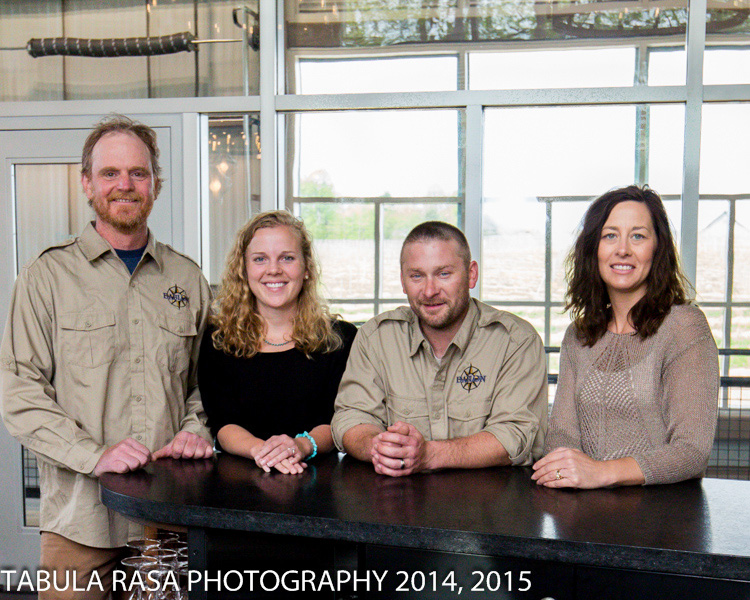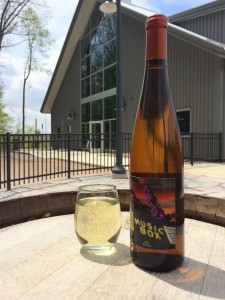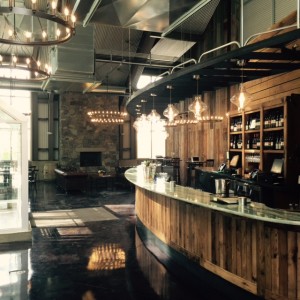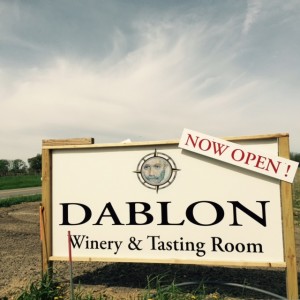Burgundy Flair in Michigan: Dablon Winery Debuts

Left to right, Winemaker, Rudy Shafer, Tasting Room Manager, Laura Gelder, Winemaker, Chad Hartline, Business Manager, Amy Hemphill.
If I had to use one word to describe Dablon Vineyards and Winery, it would be refined. The winery and vineyard does an impressive job of mixing old world winemaking with modern style and class.
The craftsmanship and attention to detail is easily noticed when entering the tasting room. It is a beautiful space with enough room for visitors to sample and socialize. Laura Gelder, Tasting Room Manager, shares my sentiment. ‘How could I turn this down?” she says as we discuss her move to Dablon from another local winery earlier in the year.
Dablon Vineyards, formerly known as Moraine Vineyards, recently changed its name to honor Claude Dablon. It is an appropriate reference, given that Dablon was Michigan explorer during the 1600’s with a history of winemaking. The winery planted its first four acres of Pinot Noir and Chardonnay grapes in 2009. Dablon has expanded to 28 acres and a larger variety of grapes, including Carmenere, Tannat, and Malbec. When I asked about future expansion plans, Laura replies with ‘Pinot Gris. We just purchased the vines this week.”

Dablon Winery owner William Schopf is also owner of the The Music Box Theater on Southport Avenue in Chicago.
Dablon’s mission is to successfully grow the less common European vinifera grapes in this area. In Michigan, the most common vinifera grape is Riesling. ‘Generally speaking, Michigan wines can have a connotation as sweet wines,” says Gelder. She goes on to share that when Dablon’s founder William Schopf decided to pursue winemaking, he tailored it to his affinity for the wines produced in the Burgundy region of France.
There are many challenges to taking on this mission, most of which revolve around Southwest Michigan’s extreme climate. Needless to say, it is not an exact match with the areas known for producing these rich wines. The annual snowfall average is 75 inches and the average temperate in January is 25F (compared to 45F in the Burgundy region). This is where the Dablon team goes the extra mile to bring their vision to fruition. In the fall, canes are placed down on the ground then covered with straw. The vines are then placed back on the wires in the spring.
I ask Rudy Shafer and Chad Hartline, Dablon’s co-winemakers, to describe the winemaking process. They share how the grapes are both hand picked and hand inspected. ‘If you don’t want it in your mouth, it doesn’t go into the wine.” Fair enough, I say. ‘The effort is worth it to get quality wine, and it’s only going to get better with time.”
As we talk, I sample the Malbec. The wine packs the same punch as any Malbec produced in warmer climates. It falls off the palate with a smooth, velvety finish. It has flavor, strength, and subtlety all in the same note. My reaction mimics that of other patrons. ‘One of our tasting room staff had to convince a visitor last weekend that we grow these grapes on the estate. He assumed we sourced them in.”
Dablon is planning Grand Opening events on June 12th and June 13th from 11 a.m. to 7 p.m. On both days, the team will be serving up barrel samples of Malbec & Cabernet Sauvignon. They will also host a live band and food truck from 1 p.m. to 3 p.m. on June 13th. Visit http://www.dablon.com for more details.



